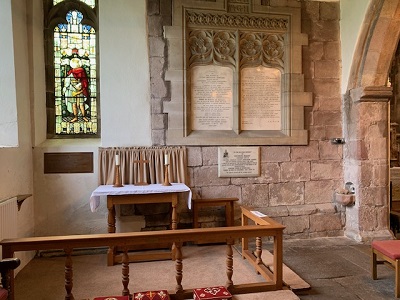
The eastward extension of the north aisle is called the Levens Chapel as, since 1597, it has belonged to the Levens Hall estate.
The existence of a holy water stoop, on the east wall, indicates that the chapel was built before 1530, when Roman Catholic observances were practised. Also, an external-type plinth suggests that the chapel post-dates the vestry built on the other side of the wall in c 1460. Similarly, the chapel’s north window appears to be 14th century, and might have been the church’s east window before the perpendicular altar window was created after 1460.
The elevated floor level is higher than the pulpit because it covers a, so far uninvestigated, burial vault. Therefore, worshippers in the family pew resembled an audience in a theatre box. A carving of the Bellingham crest of three bugle, or hunting, horns may be seen high up on the north wall, above the ‘private’ entrance door and refers to the owners of Levens Hall in the 16th century.
The handsome Jacobean screen of 14 turned balusters originally enclosed the entire chapel. The pew for the family was installed in the 19th century. The desire to worship privately during a public service, which started with family chapels, led to box pews with doors being provided for the general congregation. Heversham’s open pews, designed by Hubert Austin, were installed in c 1870 and are described by Pevsner’s Buildings of England as being of high quality. The Levens Chapel’s two-pointed arches are probably medieval, but the thin central pillar was possibly inserted when the Dorothy Bellingham’s monument was fixed to it in the 1630s.
Between 1943 and 1980, a Children’s Corner occupied the Chapel, permission having been obtained from Mrs Bagot as her husband (the Squire of Levens) could not be contacted as he was a prisoner of the Germans. In 1980, the area was reordered as a Lady Chapel, with furnishings matching the 17th-century woodwork, but it is also used for other worshipping purposes and for private prayer.
The closure of the Children’s Corner reflected social and religious changes since the 1960s, when restrictions on recreational activities on Sundays increasingly disappeared. The Lord’s Day became a time of every kind of activity or work, so that children were no longer ‘sent off’ to Sunday School. Various children’s groups have operated from time to time, although the proportion of young people in the parish is far lower than in most other rural areas. A hexagonal table, made of Levens Hall oak in the 1940s by Jim Sisson, the village joiner, now functions as a coffee table in the Dallam Chapel.
Until the 1970s, Holy Communion was celebrated, mainly at a Sunday 8.00 am service. Since the introduction of Series Three and the Revised Prayer Book, Morning Prayer was replaced as the main Sunday Service by a Eucharist. Holy Communion, according to the Book of Common Prayer, is celebrated fortnightly on Sundays, alternating with a service at Milnthorpe. During the 1970s, Mission Praise hymn books replaced the more traditional Hymns Ancient and Modern.
Next: The Dallam Chapel